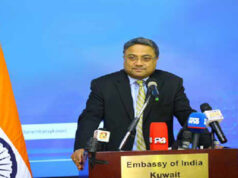The High Commissioner of Malaysia to India, H.E Dato’ Hidayat Abdul Hamid offered insight into the future of India-Malaysia bilateral relationship. He also spoke about his experiences in India, while offering insight into the strong foundation of cultural ties between the two countries.
- India is Malaysia’s 10th largest trading partner and 20th largest investor. Bilateral trade has expanded to USD 15.6 billion in 2018. Recently, Maharashtra Chamber of Commerce, Industry and Agriculture (MACCIA) signed a MOU with Malaysia-India Business Council (MIBC) in Kuala Lumpur and Malaysia hosted the eighth Malaysia-India CEO Forum (MICEOF). What according to you is the significance of such agreements and what is the future of trade between Malaysia and India?
The Cooperation Agreement between MACCIA and MIBC was signed on 25th June 2019 during MACCIA’s visit to Kuala Lumpur for the Malaysia International Food & Beverage Trade Fair 2019. MACCIA and MIBC agreed to assist each other in promoting two-way trade, investment, exchange of information, exchange of trade missions, advice on applicable local laws and regulations in keeping the interest of their members.
Such collaborations complement both our Governments effort in promoting economic cooperation whereby manufacturers and business entities are encouraged to leverage on their industry associations and chambers of commerce as the platform to spur innovation and productivity, such as in disseminating information on industry-related policies, proactive feedbacks and in conducting industry specific trainings.
The Government of Malaysia, will continue to support MICEOF in strengthening bilateral trade and investments between Malaysia and India. During the 8th MICEOF, productive discussions had involved sectors such as healthcare, infrastructure, education, agriculture and Information Technology (IT).
The future of trade is in Fourth Industrial Revolution. Global competitiveness of the manufacturing industry is set to move up the value chain beyond developmental stage to a more productive, value-added and knowledge-intensive stage.
The Government of Malaysia has taken steps to introduce many enabling policies through the Industry4WRD: National Industry 4.0 Policy Framework. This would enable the manufacturing sector to catapult into Industry 4.0 and set Malaysia to be an attractive high-technology, high-value-added manufacturing hub in the region.
The catalytic subsectors are electrical & electronic products, machinery, equipment & parts and chemicals as well as high potential growth subsectors of aerospace and medical devices. They have greater potential and strong capabilities to diversify production towards more complex and high value-added products.
Malaysia would like to attract more highly value-added and knowledge-intensive investments that will create high-income jobs. Targeted areas for trade in services include global establishments such as Principal Hub, tourism, health care, logistics, oil and gas, green technology, e-fulfilment, maintenance, repair and overhaul (MRO) for the aerospace and shipping industry, ICT, education, and professional services.
Malaysia will continue to be an open economy with business friendly environment. We are working hard to make Malaysia the preferred investment destination and a globally competitive trading nation in the world.
- Tourism is one of the largest contributors to the GDP of Malaysia. It has significantly contributed to the country’s economic growth with a share of 5.9 per cent in 2018. What initiatives are taken by Malaysia to further develop its tourism sector?
Next year 2020 is Visit Malaysia Year. The Visit Malaysia 2020 campaign has started. It aims to attract 30 million foreign tourists to visit Malaysia, which is expected to generate USD25 Billion in tourism receipt for the country.
We are working with our local partners in India through joint promotional campaigns to offer the best packages directly to the clients. Besides promoting proven traditional products, we are introducing many new products and destinations that have not been promoted before.
India is one of our most important market source. New destinations like Ipoh, Johor Bahru, Desaru, Sabah & Sarawak are being introduced highlighting exotic places and facilities for honeymoon, weddings, diving, light adventure and many more. We want tourists to explore destinations beyond the capital Kuala Lumpur.
The India outbound tourism market has been growing exponentially for the last several years. The continuous economic growth has created a bigger middle-class market with higher income, expected to expand beyond 50 million by 2020. With this huge number of Indian tourists going abroad the global tourism industry cannot ignore the Indian market.
Tourism Malaysia is putting greater emphasis on our promotional activities in India. Besides the print and electronic media, we are venturing more into the social media platform which is now getting to be a more popular tool to reach out to vast number of audiences.
To further enhance connectivity we are inviting more Indian based airlines to fly to Malaysia. Indigo, which started its services to Malaysia since mid-November 2018 is already operating 28 flights weekly to Malaysia. I believe other Indian carriers will soon follow in their footstep. The Malaysian Government has already approved several requests from Indian based airlines to add to the list of carriers operating to Malaysia. Currently, we have 238 flights weekly from 14 cities in India to Malaysia.









